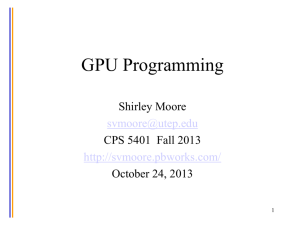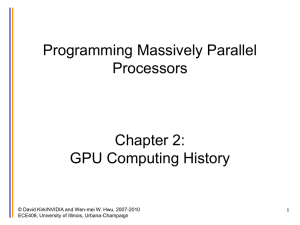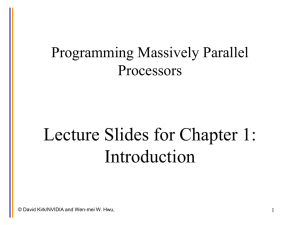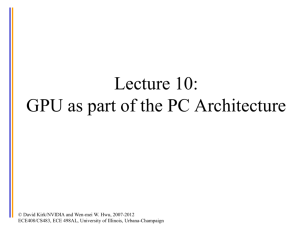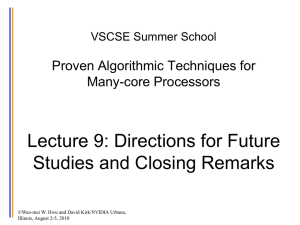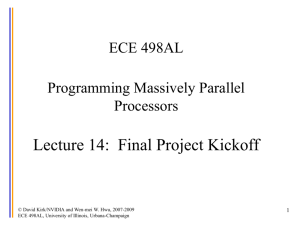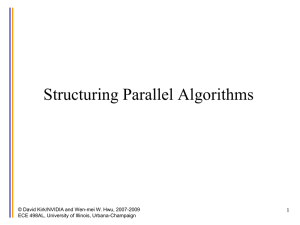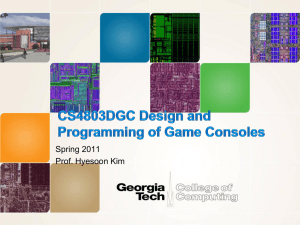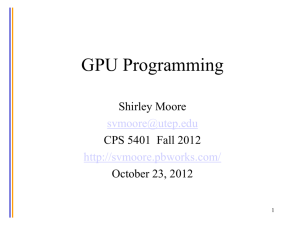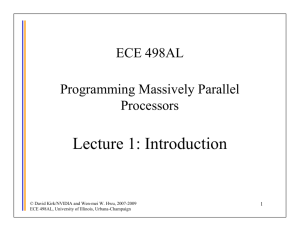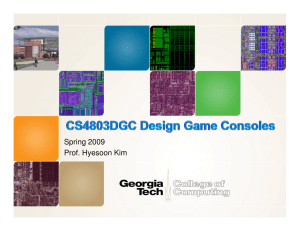Sum of Absolute Differences
advertisement
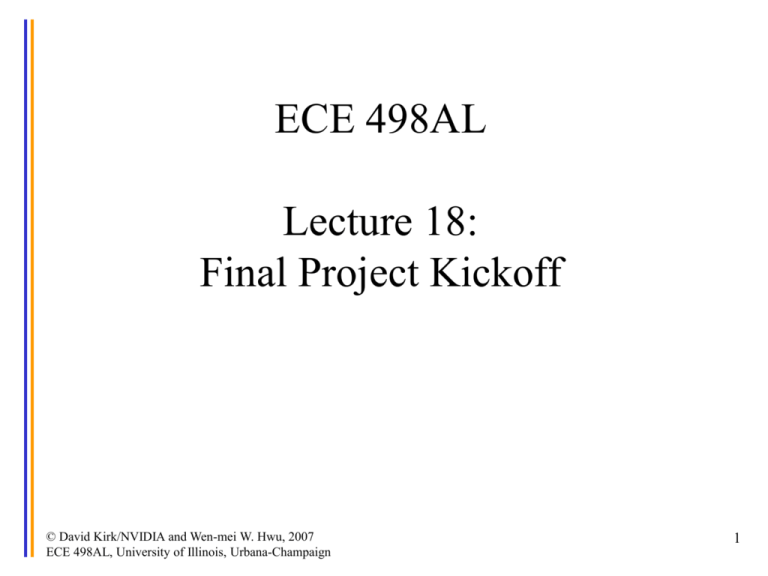
ECE 498AL Lecture 18: Final Project Kickoff © David Kirk/NVIDIA and Wen-mei W. Hwu, 2007 ECE 498AL, University of Illinois, Urbana-Champaign 1 Objective • Building up your ability to translate parallel computing power into science and engineering breakthroughs – Identify applications whose computing structures are suitable for – These applications can be revolutionized by 100X more computing power – You have access to expertise needed to tackle these applications • Develop algorithm patterns that can result in both better efficiency as well as better HW utilization – To share with the community of application developers © David Kirk/NVIDIA and Wen-mei W. Hwu, 2007 ECE 498AL, University of Illinois, Urbana-Champaign 2 Future Science and Engineering Breakthroughs Hinge on Computing Computational Geoscience Computational Chemistry Computational Medicine Computational Modeling Computational Physics Computational Biology Computational Finance © David Kirk/NVIDIA and Wen-mei W. Hwu, 2007 ECE 498AL, University of Illinois, Urbana-Champaign Image Processing 3 Faster is not “just Faster” • 2-3X faster is “just faster” – – • 5-10x faster is “significant” – – • Do a little more, wait a little less Doesn’t change how you work Worth upgrading Worth re-writing (parts of) the application 100x+ faster is “fundamentally different” – – – – Worth considering a new platform Worth re-architecting the application Makes new applications possible Drives “time to discovery” and creates fundamental changes in Science © David Kirk/NVIDIA and Wen-mei W. Hwu, 2007 ECE 498AL, University of Illinois, Urbana-Champaign 4 How much computing power is enough? • Each jump in computing power motivates new ways of computing – Many apps have approximations or omissions that arose from limitations in computing power – Every 100x jump in performance allows app developers to innovate – Example: graphics, medical imaging, physics simulation, etc. Application developers do not take us seriously until they see real results. © David Kirk/NVIDIA and Wen-mei W. Hwu, 2007 ECE 498AL, University of Illinois, Urbana-Champaign 5 A Great Opportunity for Many • Massively parallel computing allows – – – Drastic reduction in “time to discovery” New, 3rd paradigm for research: computational experimentation The “democratization of supercomputing” • • • – • $2,000/Teraflop SPFP in personal computers today $5,000,000/Petaflops DPFP in clusters in two years HW cost will no longer be the main barrier for big science This is once-in-a-career opportunity for many! Call to Action – – Research in Parallel Programming models and Parallel Architecture Teach massively parallel programming to CS/ECE students, scientists and other engineers. http://www.nvidia.com/Tesla http://developer.nvidia.com/CUDA © David Kirk/NVIDIA and Wen-mei W. Hwu, 2007 ECE 498AL, University of Illinois, Urbana-Champaign 6 The Pyramid of Parallel Programming Thousand-node systems with MPI-style programming, >100 TFLOPS, $M, allocated machine time (programmers numbered in hundreds) Hundred-core systems with CUDAstyle programming, 1-5 TFLOPS, $K, machines widely availability (programmers numbered in 10s of thousands) Hundred-core systems with MatLabstyle programming, 10-50 GFLOPS, $K, machines widely available (programmers numbered in millions) © David Kirk/NVIDIA and Wen-mei W. Hwu, 2007 ECE 498AL, University of Illinois, Urbana-Champaign 7 VMD/NAMD Molecular Dynamics • 240X speedup • Computational biology © David Kirk/NVIDIA and Wen-mei W. Hwu, 2007 ECE 498AL, University of Illinois, Urbana-Champaign 8 http://www.ks.uiuc.edu/Research/vmd/projects/ece498/lecture/ Matlab: Language of Science 15X with MATLAB CPU+GPU http://developer.nvidia.com/object/matlab_cuda.html Pseudo-spectral simulation of 2D Isotropic turbulence http://www.amath.washington.edu/courses/571-winter-2006/matlab/FS_2Dturb.m © David Kirk/NVIDIA and Wen-mei W. Hwu, 2007 ECE 498AL, University of Illinois, Urbana-Champaign 9 Spring 2007 Projects Application Description Source H.264 SPEC ‘06 version, change in guess vector 34,811 194 35% LBM SPEC ‘06 version, change to single precision and print fewer reports 1,481 285 >99% RC5-72 Distributed.net RC5-72 challenge client code 1,979 218 >99% FEM Finite element modeling, simulation of 3D graded materials 1,874 146 99% RPES Rye Polynomial Equation Solver, quantum chem, 2electron repulsion 1,104 281 99% PNS Petri Net simulation of a distributed system 322 160 >99% SAXPY Single-precision implementation of saxpy, used in Linpack’s Gaussian elim. routine 952 31 >99% TRACF Two Point Angular Correlation Function 536 98 96% FDTD Finite-Difference Time Domain analysis of 2D electromagnetic wave propagation 1,365 93 16% 490 33 >99% Computing a matrix Q, a scanner’s configuration in MRI-Q reconstruction © David Kirk/NVIDIA MRI and Wen-mei W. Hwu, 2007 ECE 498AL, University of Illinois, Urbana-Champaign Kernel % time 10 Speedup of GPU-Accelerated Functions 457 316 431 263 210 79 GPU Speedup Relative to CPU 60 50 40 Ke rn e l Ap p lic a tio n 30 20 10 0 H .2 6 4 LBM R C 5 -7 2 F EM R PES PN S SA XPY T PA C F FDTD M R I-Q M R IFHD • GeForce 8800 GTX vs. 2.2GHz Opteron 248 • 10 speedup in a kernel is typical, as long as the kernel can occupy enough parallel threads • 25 to 400 speedup if the function’s data requirements and control flow suit the GPU and the application is optimized • Keep in mind that the speedup also reflects how suitable the CPU is for executing the kernel © David Kirk/NVIDIA and Wen-mei W. Hwu, 2007 11 ECE 498AL, University of Illinois, Urbana-Champaign Student Parallel Programming Results App. Archit. Bottleneck Simult. T Kernel X App X LBM Shared memory capacity 3,200 12.5 12.3 RC5-72 Registers 3,072 17.1 11.0 FEM Global memory bandwidth 4,096 11.0 10.1 RPES Instruction issue rate 4,096 210.0 79.4 PNS Global memory capacity 2,048 24.0 23.7 LINPACK Global memory bandwidth, CPU-GPU data transfer 12,288 19.4 11.8 TRACF Shared memory capacity 4,096 60.2 21.6 FDTD Global memory bandwidth 1,365 10.5 1.2 MRI-Q Instruction issue rate 8,192 457.0 431.0 © [HKR David Kirk/NVIDIA and Wen-mei W. Hwu, 2007 HotChips-2007] ECE 498AL, University of Illinois, Urbana-Champaign 12 Magnetic Resonance Imaging • 3D MRI image reconstruction from non-Cartesian scan data is very accurate, but compute-intensive • 416 speedup in MRI-Q (267.6 minutes on the CPU, 36 seconds on the GPU) – CPU – Athlon 64 2800+ with fast math library • MRI code runs efficiently on the GeForce 8800 – High-floating point operation throughput, including trigonometric functions – Fast memory subsystems • Larger register file • Threads simultaneously load same value from constant memory • Access coalescing to produce < 1 memory access per thread, per loop © David Kirk/NVIDIA and iteration Wen-mei W. Hwu, 2007 ECE 498AL, University of Illinois, Urbana-Champaign 13 Computing Q: Performance 1400 Runtime (minutes) 1200 1164.1 1156.5 953.9 1000 416x 923.7 800 600 400.1 400 267.6 200 3.3 0.6 0 V1 (cpu,dp) V2 (cpu, dp, V3 (cpu, dp, V4 (cpu, sp) V5 (cpu, sp, V6 (cpu, sp, V7 (gpu, sp) V8 (gpu, sp, sse2) sse2, fm) sse2) sse2, fm) fm) CPU (V6): 230 MFLOPS © David Kirk/NVIDIA and Wen-mei W. Hwu, 2007 ECE 498AL, University of Illinois, Urbana-Champaign GPU (V8): 96 GFLOPS 14 MRI Optimization Space Search Each curve corresponds to a tiling factor and a thread granularity. 14 Execution Time 12 10 8 6 4 2 1 GPU Optimal 145 GFLOPS Unroll Factor 2 © David Kirk/NVIDIA and Wen-mei W. Hwu, 2007 ECE 498AL, University of Illinois, Urbana-Champaign 4 8 16 15 H.264 Video Encoding (from SPEC) • GPU kernel implements sum-of-absolute difference computation – Compute-intensive part of motion estimation – Compares many pairs of small images to estimate how closely they match – An optimized CPU version is 35% of execution time – GPU version limited by data movement to/from GPU, not compute • Loop optimizations remove instruction overhead and redundant loads • …and increase register pressure, reducing the number of threads that can run concurrently, exposing texture cache latency © David Kirk/NVIDIA and Wen-mei W. Hwu, 2007 ECE 498AL, University of Illinois, Urbana-Champaign 16 Large and Discontinuous Spaces Sum of Absolute Differences • More complex than matrix multiplication, but still relatively small (hundreds of lines of code) • Many performance discontinuities • To be presented at GPGPU ‘07 • Search spaces can be huge! Exhaustive search with smaller-than usual data sets still takes significant time. © David Kirk/NVIDIA and Wen-mei W. Hwu, 2007 ECE 498AL, University of Illinois, Urbana-Champaign 17 Analytical Models Help Reduce Search Space. Sum of Absolute Differences By selecting only Pareto-optimal points, we pruned the search space by 98% and still found the optimal configuration © David Kirk/NVIDIA and Wen-mei W. Hwu, 2007 ECE 498AL, University of Illinois, Urbana-Champaign 18 LBM Fluid Simulation (from SPEC) • Simulation of fluid flow in a volume divided into a grid – It’s a stencil computation: A cell’s state at time t+1 is computed from the cell and its neighbors at time t • Synchronization is required after each timestep – achieved by running the kernel once per timestep • Local memories on SMs are emptied after each kernel invocation – Entire data set moves in and out of SMs for every time step Flow through a cell (dark – High demand on bandwidth blue) is updated based on its • Reduce bandwidth usage with softwaremanaged caching flow and the flow in 18 neighboring cells (light blue). – Memory limits 200 grid cells/threads per SM – Not enough threads to completely cover global memory latency © David Kirk/NVIDIA and Wen-mei W. Hwu, 2007 ECE 498AL, University of Illinois, Urbana-Champaign 19 Prevalent Performance Limits Some microarchitectural limits appear repeatedly across the benchmark suite: • Global memory bandwidth saturation – Tasks with intrinsically low data reuse, e.g. vector-scalar addition or vector dot product – Computation with frequent global synchronization • Converted to short-lived kernels with low data reuse • Common in simulation programs • Thread-level optimization vs. latency tolerance – Since hardware resources are divided among threads, low per-thread resource use is necessary to furnish enough simultaneously-active threads to tolerate longlatency operations – Making individual threads faster generally increases register and/or shared memory requirements – Optimizations trade off single-thread speed for exposed latency © David Kirk/NVIDIA and Wen-mei W. Hwu, 2007 ECE 498AL, University of Illinois, Urbana-Champaign 20 What you will likely need to hit hard. • Parallelism extraction requires global understanding – Most programmers only understand parts of an application • Algorithms need to be re-designed – Programmers benefit from clear view of the algorithmic effect on parallelism • Real but rare dependencies often need to be ignored – Error checking code, etc., parallel code is often not equivalent to sequential code • Getting more than a small speedup over sequential code is very tricky – ~20 versions typically experimented for each application to move away from architecture bottlenecks © David Kirk/NVIDIA and Wen-mei W. Hwu, 2007 ECE 498AL, University of Illinois, Urbana-Champaign 21
